Perseus constellation lies in the northern sky, next to Andromeda. It was named after the hero Perseus in Greek mythology.
Perseus is one of the larger northern constellations. It was first catalogued by the Greek astronomer Ptolemy in the 2nd century. The constellation is best known for its annual Perseid meteor shower.
It is also home to the famous variable star Algol, Beta Persei. Perseus also contains a number of famous deep sky objects, among them Messier 34, the Double Cluster, the California Nebula (NGC 1499), the Fossil Footprint Nebula (NGC 1491), and the Little Dumbbell Nebula (Messier 76).
Facts, location and map
Perseus is the 24th largest constellation in the sky, occupying an area of 615 square degrees. It is located in the first quadrant of the northern hemisphere (NQ1) and can be seen at latitudes between +90° and -35°. The neighboring constellations are Andromeda, Aries, Auriga, Camelopardalis, Cassiopeia, Taurus and Triangulum.
The constellation name Perseus is pronounced /ˈpɜːrsiəs/. In English, the constellation is known as Perseus or the Hero. The genitive form of Perseus, used in star names, is Persei (pronunciation: /ˈpɜːrsiaɪ/). The three-letter abbreviation, adopted by the International Astronomical Union (IAU) in 1922, is Per.
Perseus belongs to the Perseus family of constellations, along with Andromeda, Auriga, Cassiopeia, Cepheus, Cetus, Lacerta, Pegasus, and Triangulum.
Perseus contains two Messier objects – Messier 34 (M34, NGC 1039) and Messier 76 (M76, Little Dumbbell Nebula, NGC 650 & NGC 651) – and has six stars with confirmed planets. The brightest star in the constellation is Mirfak, Alpha Persei, with an apparent magnitude of 1.79. There are two meteor showers associated with the constellation; the Perseids and the September Perseids.
Perseus contains nine named stars. The proper names of stars that have been officially approved by the International Astronomical Union (IAU) are Algol, Atik, Berehinya, Dajiangjunbei, Menkib, Miram, Mirfak, Misam, and Muspelheim.
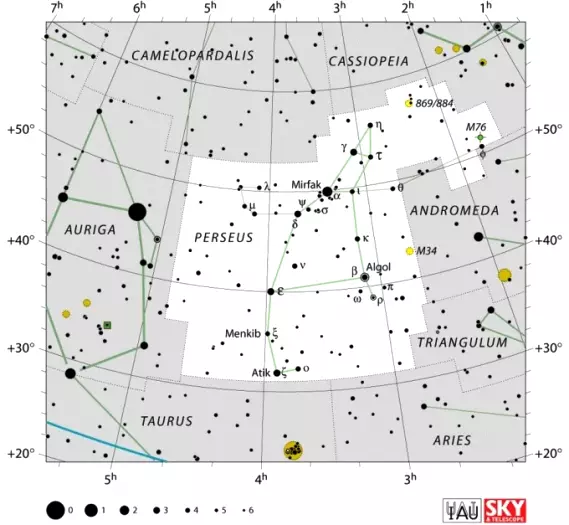
Perseus constellation map by IAU and Sky&Telescope magazine
How to find Perseus
Perseus is very easy to find because it has a distinctive shape and is surrounded by several recognizable patterns: Cassiopeia’s W to the north, Auriga‘s hexagon with the bright Capella to the east, the Pleiades to the south, and the chain of three brightest stars in Andromeda to the west.
Perseus constellation is dominated by a curved pattern of stars known as the Segment of Perseus. The curved line begins with the orange supergiant Miram (Eta Persei) and runs through Gamma Persei and Mirfak (Alpha Persei) to Sigma, Psi and Delta Persei in the central part of the constellation. The Segment is easily found by following the imaginary line from Gamma Cassiopeiae (the central star of Cassiopeia’s W) through Ruchbah (Delta Cassiopeiae, the bottom right star of the W). Mirfak, the brightest star in Perseus, is also the brightest star along this imaginary line.
Mirfak can also be found using the bright stars of Andromeda and Pegasus. Andromeda’s three brightest stars form a chain that begins with Alpheratz at the northeast corner of the Great Square of Pegasus, and runs through Mirach to Almach. Mirfak appears as an extension of the chain. The famous variable star Algol, the second brightest star in Perseus, is found south of Mirfak.
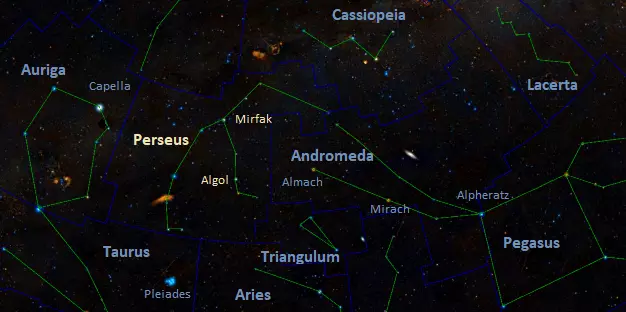
The location of Perseus, image: Wikisky
Myth
The constellation Perseus represents the Greek hero Perseus in the sky and is one of the six constellations associated with the myth of Perseus. Perseus was the son of Danaë, daughter of King Acrisius. Acrisius ruled Argos and after an oracle foretold him that he would meet his end at the hand of his own grandson, he had locked away Danaë in a dungeon. Zeus fell in love with her and took the form of golden rain to visit her. When the rain fell into her lap, Danaë got pregnant. Acrisius found out about the pregnancy and, once Perseus was born, the king locked both his daughter and grandson into a wooden chest and cast them out to sea.
Danaë prayed to Zeus and the god heard her. The chest washed ashore within a few days, and Perseus and his mother found themselves on the island of Seriphos. A fisherman called Dictys found them and took them home with him. He raised Perseus as his own son.
However, their troubles did not end there. Dictys had a brother, King Polydectes, who wanted Danaë for himself. Perseus defended her from the king’s advances and Polydectes came up with a plan that would put Perseus out of the picture. He made up a story about being engaged to another woman, Hippodameia, who was the daughter of King Oenomaus of Elis. He asked everyone to give him and his bride horses as a wedding present. Since Perseus did not have any horses and could not afford to buy one, the king sent the youngster to bring him the head of the Gorgon Medusa.
Medusa was one of the three hideous sisters, who had tusks, hands of brass, golden wings, and faces covered with dragon scales. They were daughters of the sea god Phorcys and his sister Ceto. Their gaze could turn anyone who looked at them into stone.
Medusa was the only mortal sister. She had been condemned to a life of ugliness by the goddess Athena after Poseidon had ravished Medusa in the goddess’ temple. Before the curse, she was known for her beauty, especially of her hair. Once cursed, she had snakes for hair, which made her distinguishable from the other two Gorgons.
Polydectes expected Perseus to meet his end in the attempt to defeat the Gorgon, but he underestimated Perseus’ allies on Olympus. Athena gave the hero a bronze shield and Hephaestus made him a sword of diamond. Hades gave him a helmet that made him invisible, and Hermes gifted him with winged sandals.
Helped by Athena, Perseus found the Gorgon sisters on Mount Atlas. The Gorgons’ sisters, called the Graeae, were standing guard. The three of them had only one eye and shared it among themselves. Perseus took the eye and threw it away.
Following the trail of people turned to stone by Medusa and her sisters, Perseus found the Gorgons. He was wearing his helmet which made him invisible and he was able to sneak up on the sisters. Once they had fallen asleep, Perseus beheaded Medusa using his shield to see her reflection, as he could not look at her directly without turning into stone. The myth goes, when Medusa was defeated the winged horse Pegasus and the warrior Chrysaor, fully armed, sprang fully grown from her body. They were the offspring of the Gorgon and the sea god Poseidon.
On the way home, Perseus stopped to rest in Atlas’ kingdom. Atlas refused him hospitality and Perseus used Medusa’s head to turn him into stone, or into the mountain range that bears his name. Later, Perseus came across the princess Andromeda, who was chained to a rock and left to the sea monster Cetus by her parents, King Cepheus and Queen Cassiopeia, to appease the monster. Perseus rescued Andromeda and took her home with him.
Once home in Seriphos, Perseus found his mother and foster father Dictys hiding from Polydectes in a temple. Perseus went to see the king and, greeted with hostility, he used the Gorgon’s head to turn Polydectes and his followers to stone. He appointed Dictys king of Seriphos.
The old prophecy about King Acrisius meeting his end at the hands of his grandson came true eventually, but the king’s passing came as an accident. At an athletics contest, Perseus threw a discus that accidentally hit Acrisius.
Andromeda and Perseus were married and had many children, among them Perses, who was said to be an ancestor to the kings of Persia.
Perseus and Andromeda lie next to each other in the sky, with her parents Cepheus and Cassiopeia nearby. Cetus, the sea monster, also lies in the vicinity, as does Pegasus, the winged horse.
Perseus is usually depicted holding the head of Medusa in one hand and the jewelled sword in the other. The Gorgon’s head is represented by the famous variable star Algol, Beta Persei.
Perseus stars
Mirfak – α Persei (Alpha Persei)
Alpha Persei is a supergiant star belonging to the spectral class F5 Ib. It has a visual magnitude of 1.806 and is approximately 510 light years distant. It is the brightest star in Perseus constellation and one of the brightest stars in the sky.
Mirfak is circumpolar in latitudes north of New York City; it never sets under the horizon. It is located in a star cluster known as the Alpha Persei Cluster, which can easily be seen in binoculars.
Alpha Persei has 7.3 solar masses and is about 60 times the size of the Sun and 5000 times more luminous.
The star’s traditional names, Mirfak and Algenib, mean “elbow” and “flank” or “side” respectively in Arabic. Gamma Pegasi in the nearby constellation Pegasus is now formally known as Algenib.
Algol – β Persei (Beta Persei)
Algol, the Demon Star, is one of the best known stars in the sky. It was the first eclipsing binary star ever discovered and one of the first variable stars to be found.
Beta Persei is in fact a triple star system composed of the primary star Beta Persei A which is eclipsed by Beta Persei B. The apparent magnitude of the system is around 2.1, but it drops to 3.4 every two days, 20 hours and 49 minutes, and stays dimmer for about 10 hours, which is how long the eclipses last.
A secondary eclipse occurs when the primary component occults the dimmer star. Algol is a prototype for a class of stars known as Algol variables.
Algol A belongs to the spectral class B8V, Algol B to K0IV, and Algol C to A5V. Algol A and Algol B are separated by only 0.062 astronomical units, and Algol C is 3.69 AU away from the pair.
The discovery of Algol’s binary nature and a closer look at its components shook one of the fundamental beliefs in stellar evolution, which says that stars’ rates of evolution depend on their mass. Even though Algol A is more massive, it is still on the main sequence, while Algol B is less massive yet already in the subgiant evolutionary stage. This is because the more massive star filled its Roche lobe when it became a subgiant and most of its mass was transferred to the other star. (The Roche lobe is the space around a star in a binary system within which orbiting material is gravitationally bound to the star. If the star expands beyond this region, the material can escape its gravitational pull.)
The Algol system emits x-rays and radio wave flares. The x-rays are believed to be the result of the two components’ magnetic fields interacting with the mass transfer, and the radio waves are suspected to have been created by magnetic cycles and the result of the stars’ magnetic fields being up to ten times stronger than that of the Sun.
Algol has an apparent magnitude of 2.12 and is 92.8 light years distant. It passed within 9.8 light years of the solar system about 7.3 million years ago and its apparent magnitude at the time was -2.5, which made it much brighter than Sirius, currently the brightest star in the sky, is today.
The star’s name is derived from the Arabic phrase ra’s al-ghul (yes, just like the supervillain in the Batman comics), which means “the demon’s head.” It was associated with a ghoul in Arabic tradition and with the head of the Gorgon Medusa in Greek mythology. In Hebrew tradition it was also known as the Satan’s Head, or Rōsh ha Sāṭān. The star’s Latin name in the 16th century was Caput Larvae, or the Spectre’s Head. The Chinese knew it as the Fifth Star of the Mausoleum, or Tseih She, which means piled up corpses.
Atik (Menkhib) – ζ Persei (Zeta Persei)
Zeta Persei is a blue-white supergiant star belonging to the spectral class B1 Ib. It is about 47,000 times more luminous than the Sun. It has an apparent magnitude of 2.86 and is approximately 750 light years distant. The star has a 9th magnitude companion located 12.9 arc seconds away. The two stars are suspected to be physically associated because they share the same proper motion and are on a similar trajectory.
ε Persei (Epsilon Persei)
Epsilon Persei is composed of several stars. The system has a combined visual magnitude of 2.88 and is about 640 light years distant from the Sun. The primary star in the system is classified as a Beta Cephei variable with a primary pulsation period of 0.1603 days.
The two main components in the Epsilon Persei system orbit each other with a period of 14 days. The system may have a third component, but its existence has not been confirmed. The primary component is a main sequence star belonging to the spectral type B0.5V, about 28,000 times more luminous than the Sun. The secondary star belongs in the spectral range between A6 V and K1 V and is much smaller than the primary component, with only between 6 and 13 percent of the primary’s mass.
γ Persei (Gamma Persei)
Gamma Persei is a double star with a combined visual magnitude of 2.93, approximately 243 light years distant from Earth. It is the fourth brightest star in Perseus.
Gamma Persei is composed of a giant of the spectral type G9 III and a companion star which is usually classified either as A3V or A2III. The system is a wide eclipsing binary star, with the two stars orbiting each other every 14.6 years. The primary component passes in front of the companion and the combined magnitude of the system drops by 0.55.
δ Persei (Delta Persei)
Delta Persei is a binary star with a visual magnitude of 3.01, approximately 520 light years distant. It belongs to the spectral class B5 III, which makes it a blue-white giant star. It is seven times more massive than the Sun and believed to be about 6.8 million years old. The star is a rapid rotator, with a projected velocity of 190 km s–1.
Delta Persei is believed to be a double star, and possibly even a triple star system. It has a visual companion about 0.330 arc seconds away. The companion has a visual magnitude of 6.17. The companion may be gravitationally bound to the main star and not just an optical double, but this has not been confirmed.
Gorgonea Tertia – ρ Persei (Rho Persei)
Rho Persei is classified as a semiregular Mu Cephei-type variable star. The star’s traditional name, Gorgonea Tertia, refers to the myth of Perseus and the Gorgons. It represents the third Gorgon sister in the constellation.
Rho Persei is visible to the unaided eye. It has an apparent magnitude of 3.39 and is about 308 light years distant. The star’s magnitude varies from 3.3 and 4.0.
The star belongs to the spectral type M4 II, which means that it has reached the asymptotic giant branch stage of evolution, and is near the tip of the red giant branch.
Rho Persei is five times as massive as the Sun and has a radius 150 times solar. It is 2,290 times more luminous. The star’s estimated age is about 440 million years.
Miram – η Persei (Eta Persei)
Eta Persei belongs to the spectral class K3 and is approximately 1331 light years distant from the solar system. It has a visual magnitude of 3.76 and is about 35,000 times more luminous than the Sun.
Misam – κ Persei (Kappa Persei)
Kappa Persei is a triple star system about 112 light years away in the direction of Perseus constellation. It is a K0 III class star with a visual magnitude of 3.8.
The Kappa Persei system consists of a spectroscopic binary star and a companion in a wider orbit.
ν Persei (Nu Persei)
Nu Persei is a luminous yellow-white giant star belonging to the spectral class F5 II. It is approximately 556 light years distant and has a visual magnitude of 3.77.
Atik – ο Persei (Omicron Persei)
Omicron Persei is another spectroscopic double in Perseus. It consists of a giant star of the spectral type B1 and a dwarf belonging to the class B3. The two orbit each other with a period of 4.5 days. The star’s traditional name, Atik (or Al Atik) comes from the Arabic word for “the shoulder.”
Omicron Persei is between 1000 and 1600 light years distant from the solar system and has an apparent magnitude of 3.83.
If the name sounds familiar, it is because Omicron Persei has been featured in a number of works of science fiction, most famously in the TV series Futurama, but also in Transformers, Star Trek and Mystery Science Theater 3000.
Menkib – ξ Persei (Xi Persei)
Xi Persei is a blue giant with a visual magnitude of 4.042, approximately 1800 light years distant from the Sun. Its traditional name, Menkib, means “the shoulder” in Arabic.
Menkib belongs to the spectral class O7.5III. It is about 40 times more massive than the Sun and one of the hottest visible stars. It has a surface temperature of 37,000 K.
Dajiangjunbei – φ Persei (Phi Persei)
Phi Persei is a double star consisting of a B2-class main sequence star and a subdwarf. The primary star has a visual magnitude of 4.06. Phi Persei is classified as a Gamma Cassiopeiae variable. It shows rapid variations in luminosity and spectrum. It is approximately 720 light years distant. The star was formally named Dajiangjunbei in 2025. The name refers to an ancient Chinese constellation called Celestial Grand General. It means “the Northern One of the Great General.”
ι Persei (Iota Persei)
Iota Persei is a main sequence dwarf of the spectral type G0 V. It has a visual magnitude of 4.05 and is 34.38 light years distant from the Sun.
The star has a relatively high proper motion. It moves at the speed of 92 km/s relative to the Sun.
θ Persei (Theta Persei)
Theta Persei is a star system composed of a yellow dwarf of the spectral type F7V and a red dwarf belonging to the class M1V, located about 250 astronomical units from the primary star. The brighter dwarf has an apparent magnitude of 4.12 and the companion of 10. The system is 36.6 light years distant.
ψ Persei – Psi Persei
Psi Persei is a main sequence star belonging to the spectral class B5Ve. It has a visual magnitude of 4.310 and is approximately 580 light years distant. The star can be seen without binoculars. It is classified as a Be star, which is to say a B-class star showing prominent hydrogen emission lines in its spectrum.
Psi Persei is a shell star, which means that it is surrounded by a disc of gas at the equator line. It is a rapid rotator, with an estimated rotational velocity of 390 km/s or more along the equator.
The star is a suspected member of the Alpha Persei Cluster, but has a higher proper motion than other members.
Gorgonea Quarta – ω Persei (Omega Persei)
Omega Persei belongs to the spectral class K1III and is approximately 305 light years distant from the solar system. It has a visual magnitude of 4.63.
Gorgonea Secunda – π Persei (Pi Persei)
Pi Persei belongs to the spectral class A2Vn and has a visual magnitude of 4.7. It is 362 light years distant from the Sun.
1 Aurigae – HR 1533
1 Aurigae is an orange giant of the spectral type K3.5IIIBa0.2. It has an apparent magnitude of 4.88 and is approximately 520 light years distant.
1 Aurigae was the first star from the Auriga constellation that John Flamsteed entered in his catalogue of stars. It belongs to Perseus since 1930, when Eugène Joseph Delporte simplified the border between the two constellations. The star is now usually referred to as HR 1533.
X Persei
X Persei is a double star system with a blue main sequence star (spectral type O9.5pe) for a primary component. It has an apparent magnitude of 6.79 and is 2694 light years distant.
The star is notable because it is orbited by a neutron star, X Persei B. A neutron star is a hot remnant, composed almost entirely of neutrons, of a massive star that underwent a gravitational collapse during a Type II, Ib or Ic supernova event.
Nova Persei 1901 (GK Persei)
Nova Persei 1901, also known as GK Persei, was a bright nova that occurred in 1901. With a peak magnitude of 0.2, it was the brightest nova of modern times until 1918, when Nova Aquilae 1918 occurred.
GK Persei subsequently faded to magnitude 12 or 13, but had occasional outbursts of 2 to 3 magnitudes. In the last 30 years, the outbursts have become pretty regular and last about two months every three years or so, which makes GK Persei resemble not a typical nova, but a dwarf nova-type cataclysmic variable star.
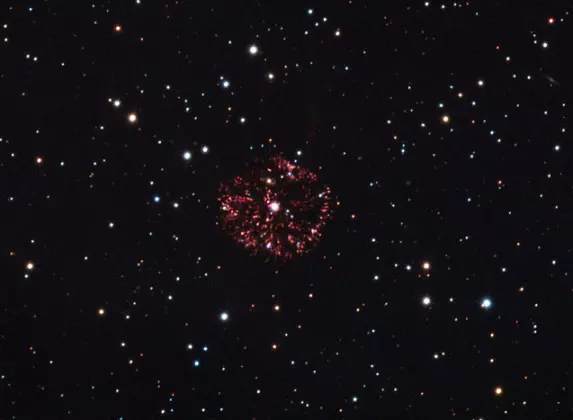
Nova Persei 1901, image: Adam Block/Mount Lemmon SkyCenter/University of Arizona (CC BY-SA 3.0)
Nova Persei 1901 is approximately 1500 light years distant from the solar system.
V713 Persei
V713 Persei is a young star belonging to the spectral class K3V, located in the young open star cluster IC 348. The star is occulted by an unknown body every 4.7 years, likely a planet six times more massive than Jupiter, located at a distance of 3.3 astronomical units away from the star.
Perseid meteor shower
The Perseids are probably the best known of all meteor showers. They can be seen every summer, from mid-July to late August in the northern hemisphere. The meteor shower peaks every year around August 13, when the rate of meteors can reach over 60 per hour, which usually happens in the hours just before the dawn. The Perseid meteor shower is associated with the Perseus constellation because its apparent point of origin, also called the radiant, is located in the constellation.
The meteor shower has been observed for some 2000 years or so, with first reports coming from the Far East. The shower is also known as the tears of St. Lawrence in some Catholic countries, as it coincides with the date of St. Lawrence’s martyrdom (August 10).
The Perseids are associated with the comet Swift-Tuttle, a periodic comet that has an orbital period of about 133 years. The comet was first discovered by Lewis Smith and Horace Parnell Tuttle, two American astronomers who independently observed it in July 1862. The comet has a solid nucleus 26 kilometres across and is the parent body of the Perseid meteor shower. It leaves a line of debris known as the Perseid cloud along its orbit. Most of the dust in the cloud is believed to be about a thousand years old.
Deep sky objects in Perseus
Messier 34 (M34, NGC 1039)
Messier 34 is an open cluster with a visual magnitude of 5.5, approximately 1,500 light years distant. It is between 200 and 250 million years old. It contains about 400 stars and is seven light years in radius.
The cluster was discovered by the Italian astronomer Giovanni Batista Hodierna in mid-17th century and included in Messier’s catalogue in 1764. In good conditions, it appears as a blurry patch slightly north of the line from Algol to Almach, Gamma Andromedae.
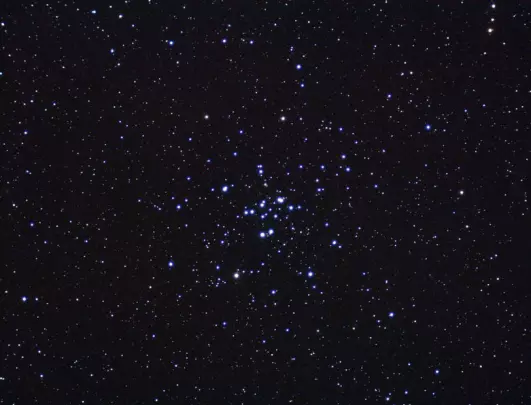
Messier 34, image: Ole Nielsen
Little Dumbbell Nebula – Messier 76 (M76, NGC 650 & NGC 651)
The Little Dumbbell Nebula is a planetary nebula in Perseus. It has a visual magnitude of 10.1 and is approximately 2500 light years distant from the Sun. It is also known as Messier 76, the Cork Nebula, and the Barbell Nebula.
The nebula was discovered by the French astronomer Pierre Méchain in 1780 and subsequently included in Messier’s catalogue. The first person to recognize it as a planetary nebula was the astronomer Heber Doust Curtis.
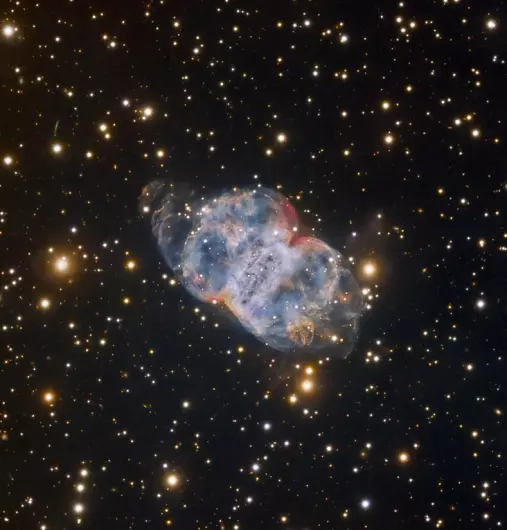
Little Dumbbell Nebula (Messier 76), image: Daniel Nobre, the Liverpool Telescope (CC BY-SA 4.0)
The Little Dumbbell Nebula is 2.7 x 1.8 arc minutes in size. It is one of the most difficult objects to observe included in Messier’s catalogue.
The nebula was originally assigned two catalogue numbers, NGC 650 and NGC 651, because it was believed to consist of two different emission nebulae.
The Little Dumbbell Nebula owes its name to the Dumbbell Nebula (Messier 27) in the constellation Vulpecula, which it resembles.
Alpha Persei Cluster (Melotte 20, Collinder 39)
The Alpha Persei Cluster is an open star cluster in Perseus. It contains several blue stars, the brightest one of which is Mirfak, Alpha Persei, a white-yellow second magnitude giant. Other bright members of the cluster include Delta, Epsilon, and Psi Persei. The estimated age of the cluster is between 50 and 70 million years.
The Alpha Persei Cluster is between 557 and 650 light years distant and has a visual magnitude of 1.2.
Perseus molecular cloud
The Perseus molecular cloud is a giant molecular cloud, or stellar nursery, located about 600 light years from the solar system.
It is 6’x2′ in size and not very bright (unless observed in mid and far-infrared wavelengths), with the exception of two clusters that it contains: IC 348 and NGC 1333.
Both clusters are sites of low-mass star formation.
Perseus Cluster – Abell 426
The Perseus Cluster is a cluster of galaxies located in Perseus constellation. It is home to thousands of galaxies and one of the most massive objects known in the universe.
The cluster is receding from us at a speed of 5,366 km/s. It is about 240.05 million light years distant.
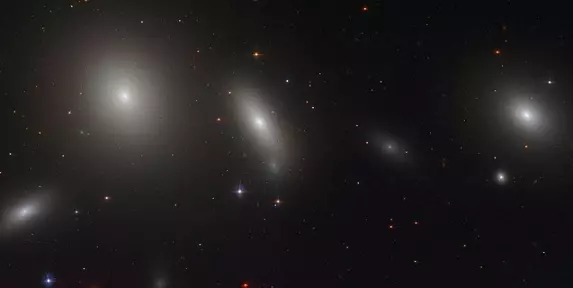
This idyllic scene, packed with glowing galaxies, has something truly remarkable at its core: an untouched relic of the ancient Universe. This relic can be seen in the large galaxy at the centre of the frame, a lenticular galaxy named NGC 1277. This galaxy is a member of the famous Perseus Cluster — one of the most massive objects in the known Universe, located some 220 million light-years from Earth. Image: Hubble ESA (CC BY 2.0)
3C 83.1B
3C 83.1B is a radio galaxy in Perseus, located in the Perseus Cluster. Its host is the elliptical galaxy NGC 1265.
The galaxy is 2.04’x1.74′ in size and has a visual magnitude of 12.63. It is classified as a Fanaroff and Riley class 1 radio galaxy, one with the brightest points in the radio emission located toward the centre.
Double Cluster (Caldwell 14, NGC 869 & NGC 884)
The Double Cluster is the name for two bright open clusters, NGC 884 and NGC 869, located in Perseus constellation. They are 7,600 and 6,800 light years distant respectively and relatively close to each other in space. Their respective ages are estimated at 3.2 and 5.6 million years, which means that they are relatively young.
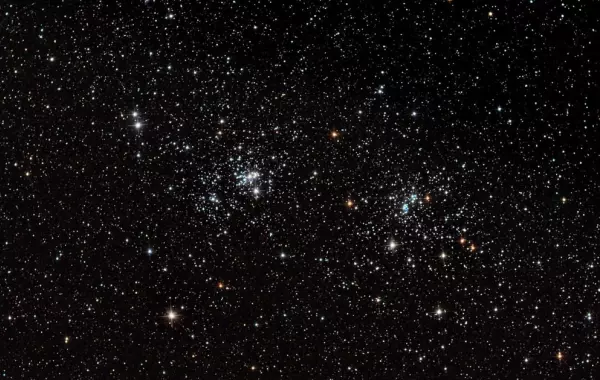
The Double Cluster (NGC 869 and NGC 884) in Perseus. Image: Rawastrodata (Nikon D300 camera on an 8″ Newtonian reflector)
The Double Cluster has a combined apparent magnitude of 4.3 and can be seen without binoculars, but observing each cluster individually requires a telescope. NGC 869 lies to the west and has a visual magnitude of 5.3, and NGC 884 is to the east and has a magnitude of 6.1.
Each cluster contains more than 300 supergiant stars. The hottest main sequence stars in the clusters belong to the spectral class B0. Both clusters are moving toward us, NGC 884 at a speed of 21 km/s, and NGC 869 at 22 km/s.
In mythology, The Double Cluster represents the jeweled handle of Perseus’ sword.
Embryo Nebula (NGC 1333)
NGC 1333 (the Embryo Nebula) is a reflection nebula in Perseus, located in the Perseus molecular cloud. It is 6′ x 3′ in size and has an apparent magnitude of 5.6. The nebula is approximately 1000 light years distant.
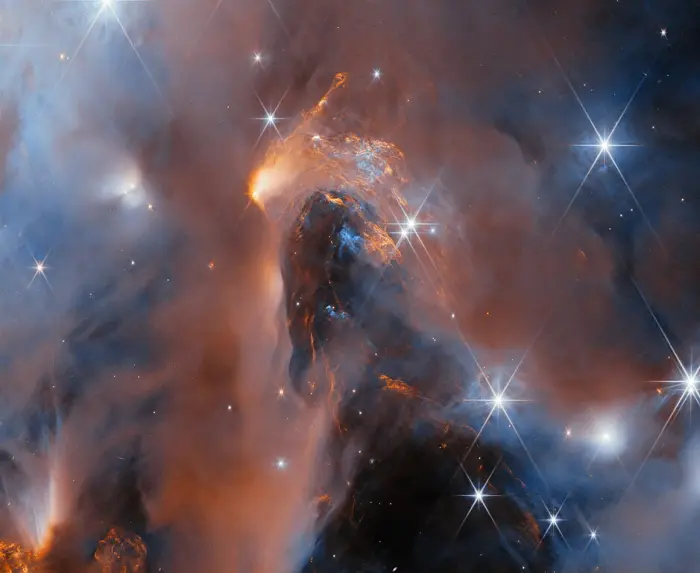
This stunning new mosaic of images from the NASA/ESA/CSA James Webb Space Telescope showcases the nearby star-forming cluster, NGC 1333. The nebula is in the Perseus molecular cloud, and located approximately 960 light-years away. Webb’s superb sensitivity allows astronomers to investigate young objects with extremely low masses. Some of the faintest ‘stars’ in the picture are in fact newly born free-floating brown dwarfs with masses comparable to those of giant planets. Image credit: ESA/Webb, NASA & CSA, A. Scholz, K. Muzic, A. Langeveld, R. Jayawardhana (CC BY 4.0)
NGC 1260
NGC 1260 is a spiral galaxy. It is notable for being home to supernova SN 2006gy, a supernova event in 2006 that was the second brightest object in the observable universe.
The galaxy has an apparent magnitude of 14.3 and is approximately 250 million light years distant.
California Nebula (NGC 1499)
The California Nebula got its name because it resembles the outline of California on a map in long exposure photographs. It is an emission nebula in Perseus, about 1000 light years distant. It has a visual magnitude of 6.0.
The nebula is about 2.5° long and not particularly bright, which makes it difficult to observe. It was discovered by the American astronomer E. E. Barnard in 1884.
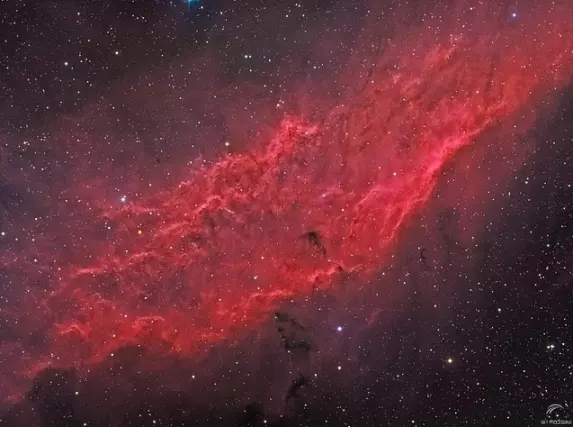
California Nebula (NGC 1499), image: Maxime Tessier (CC BY-SA 4.0)
Perseus A – NGC 1275 (Caldwell 24)
NGC 1275 is a type 1.5 Seyfert galaxy, one that corresponds with the radio galaxy Perseus A and is located at the heart of the Perseus Cluster.
The galaxy is a powerful source of radio emission and x-rays, and is believed to have a supermassive black hole at its centre. It has a visual magnitude of 12.6 and is approximately 237 million light years distant.
NGC 1275 consists of two galaxies. One is a type-cD galaxy (a giant elliptical galaxy with a large halo of stars, usually located near the centre of a rich galaxy cluster) and the other is a high velocity system (HVS) located in front of it, about 200,000 light years or more away, and moving toward the dominant system and possibly merging with the Perseus Cluster. The central galaxy is not affected by the HVS because the distance between them is too big.
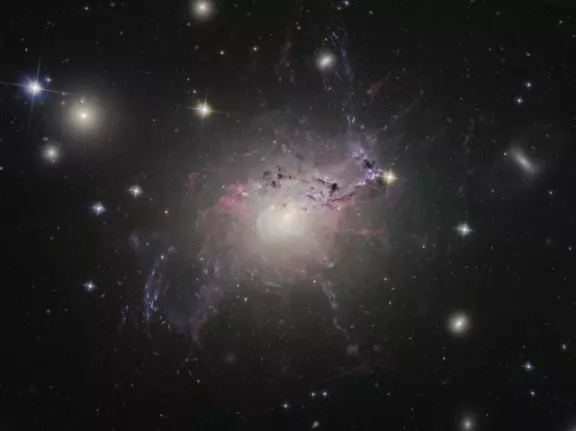
NGC 1275, image: Judy Schmidt (CC BY 2.0)
NGC 1275 is the dominant galaxy in the Perseus Cluster. It spans more than 100,000 light years.
The galaxy has a delicate network of filaments surrounding it that should be destroyed by collisions with several smaller galaxies, but aren’t. The filaments are believed to be held together by strong magnetic fields.
NGC 1058
NGC 1058 is a Seyfert Type 2 galaxy with an apparent magnitude of 11.82, approximately 27.4 million light years distant. The galaxy is moving away from Earth at the speed 518 km/s and 629 km/s relative to the Milky Way.